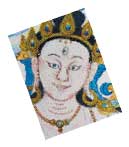Conserving
Ancient Art
 Ann
Shaftel '69 developed an unusual interest while
in elementary school: thangkas, Northern Buddhist religious
artifacts. During the past 30 years, the conservation of
this art form has become her passion and life's work. Ann
Shaftel '69 developed an unusual interest while
in elementary school: thangkas, Northern Buddhist religious
artifacts. During the past 30 years, the conservation of
this art form has become her passion and life's work.
Traditionally, thangkas accompanied traveling monasteries
and teachers and were rolled up for transport on yaks. Often
misidentified as paintings, they are in fact complicated,
three-dimensional composite objects featuring an embroidered
or painted picture panel; a textile mounting; and one or
more of the following: a silk cover, leather or metal corners,
wooden dowels, and decorative knobs. Often they were painted
using pigments from the earth and colors made from flower
petals mixed with yak hide glue.
Thangkas depict the life of Buddha, great masters, or other
subjects, and vary from shrine-size to large enough to cover
the outside of a monastery for special occasions. It often
took years to complete a thangka masterpiece.
Ann is considered a worldwide expert on thangka conservation,
and her approach combines science with traditional respect
and training. A practicing Buddhist, she refers to her work
as "delicate and labor-intensive." The pieces arrive at
her home in Nova Scotia from people and places throughout
the globe, including monasteries, Buddhist teachers, world-renowned
museums, private collectors, and individual Buddhist practitioners,
each unique  in
its age, style, iconography, and condition. The process
of conservation begins with technical photography and a
written report documenting the thangka's initial condition,
followed by a course of action designed specifically for
each piece's individual needs. Studying the silk mounting
may reveal the identity of the artist, the monastery it
was created in, and the thangka's original location in the
shrine hall. Often, however, mountings were replaced, and
may originate from different time periods or areas of the
Himalayas than the painting. in
its age, style, iconography, and condition. The process
of conservation begins with technical photography and a
written report documenting the thangka's initial condition,
followed by a course of action designed specifically for
each piece's individual needs. Studying the silk mounting
may reveal the identity of the artist, the monastery it
was created in, and the thangka's original location in the
shrine hall. Often, however, mountings were replaced, and
may originate from different time periods or areas of the
Himalayas than the painting.
Ann holds an MA in Asian art, an MS in conservation,
and a Conservation Certificate from UNESCO in Rome.
by
Melissa Ray '01
|
|



